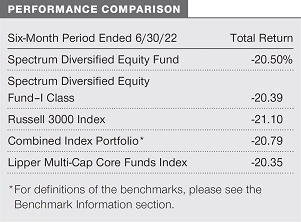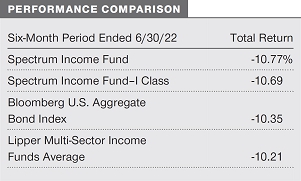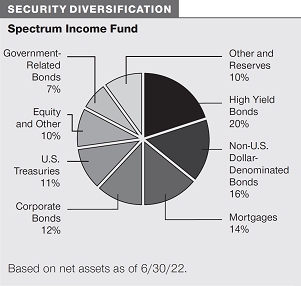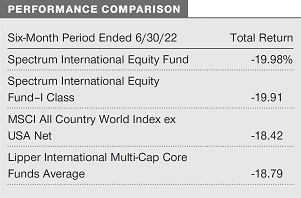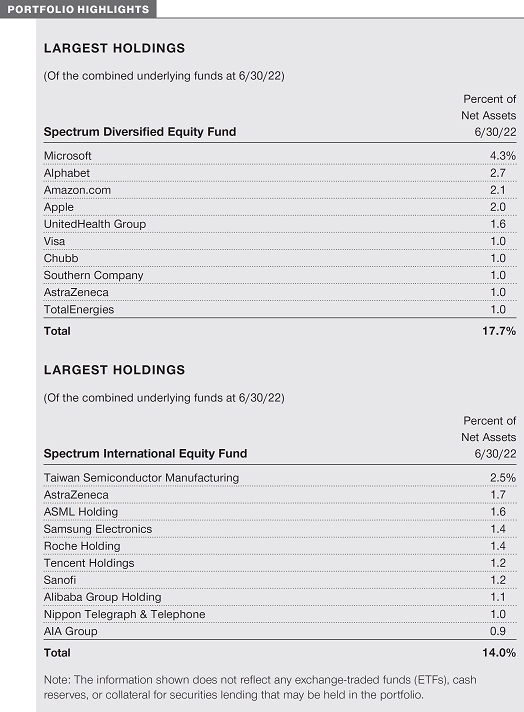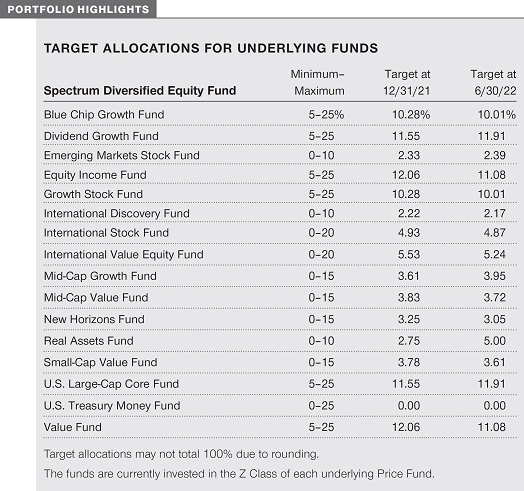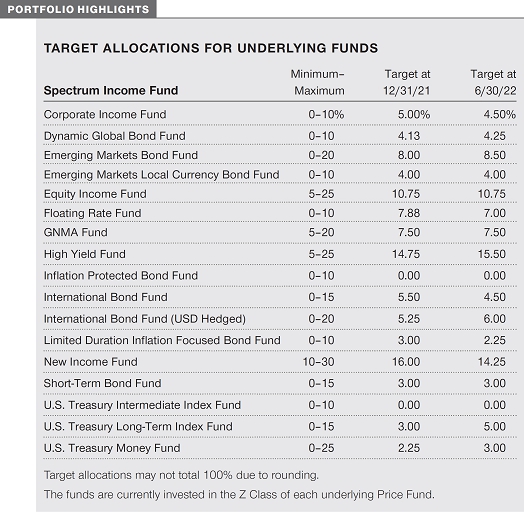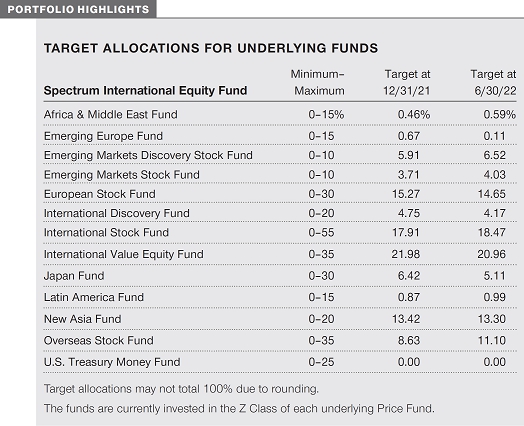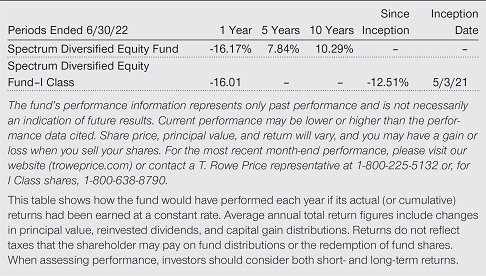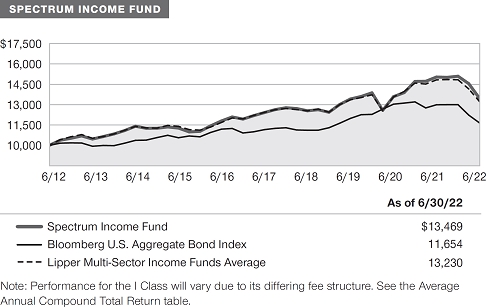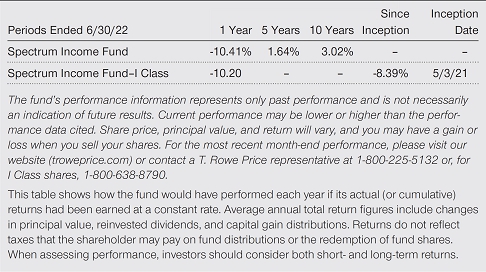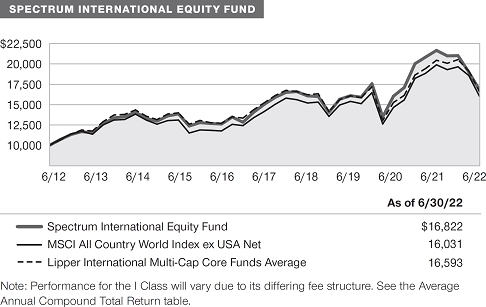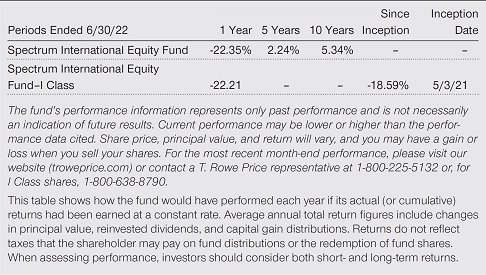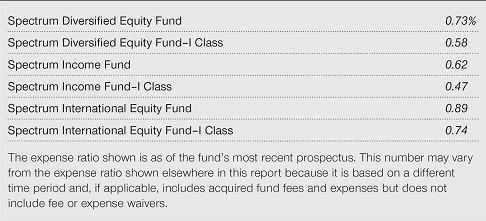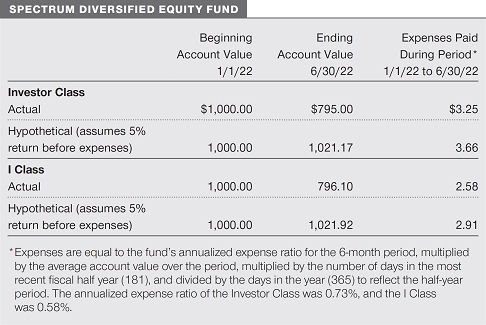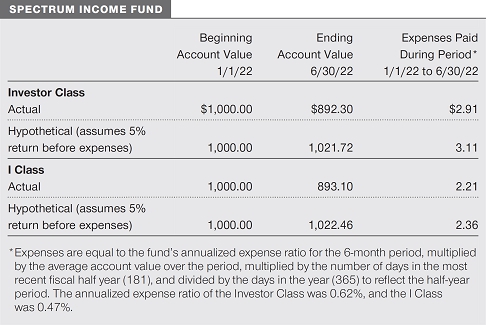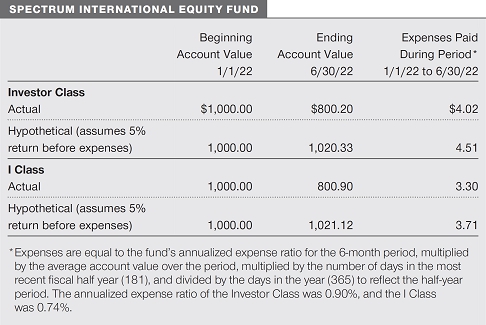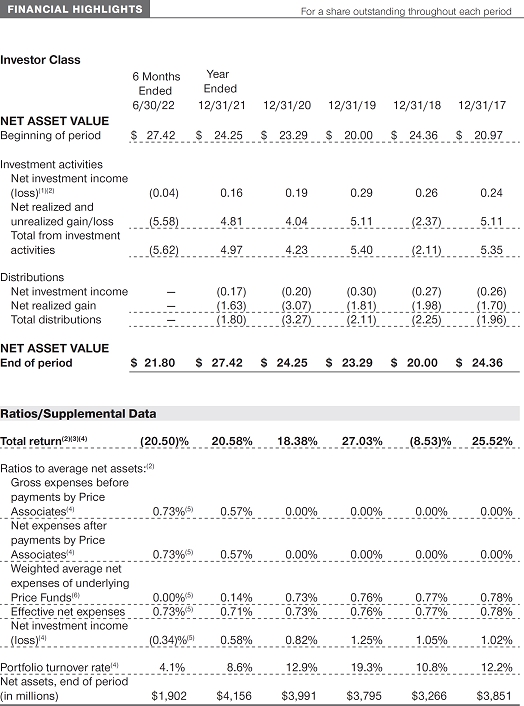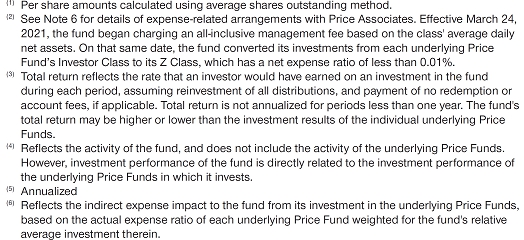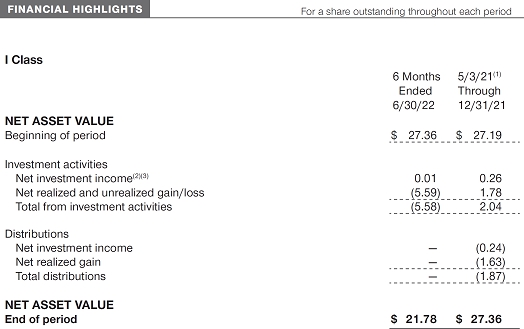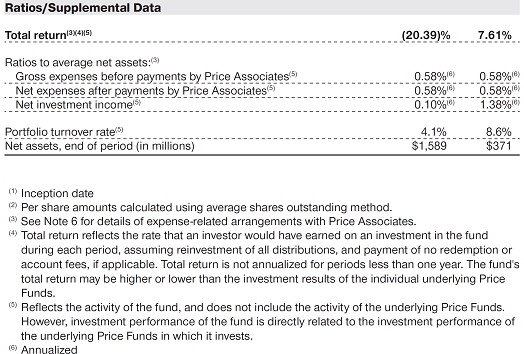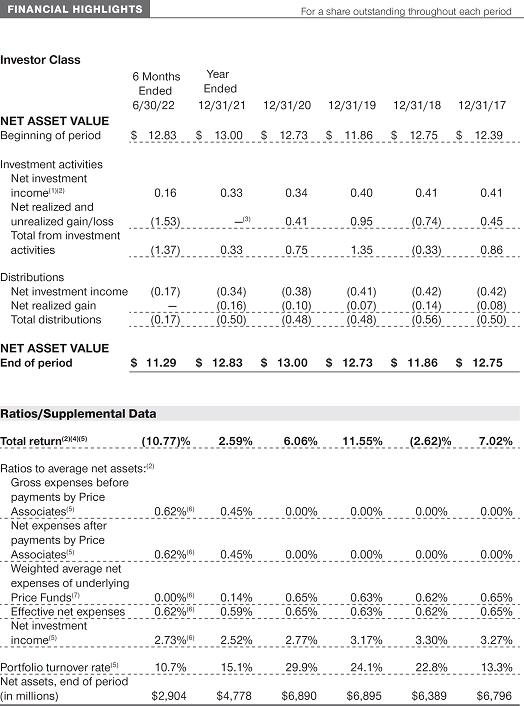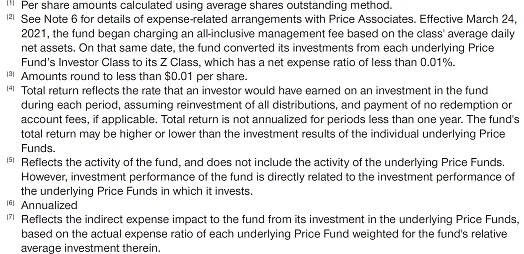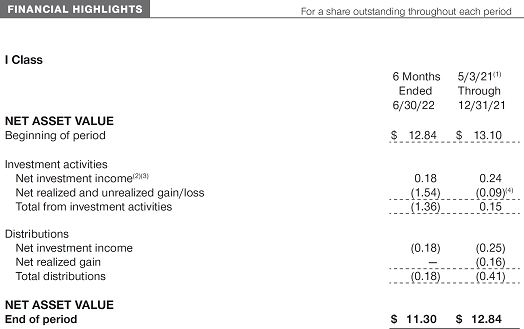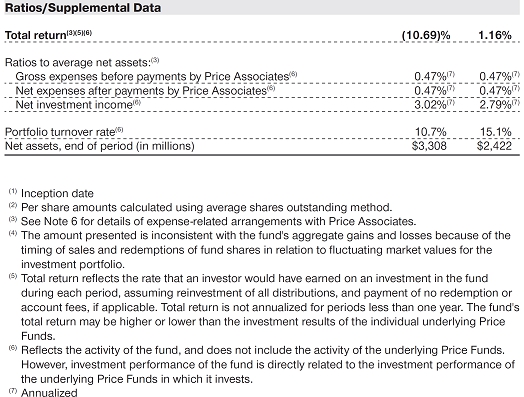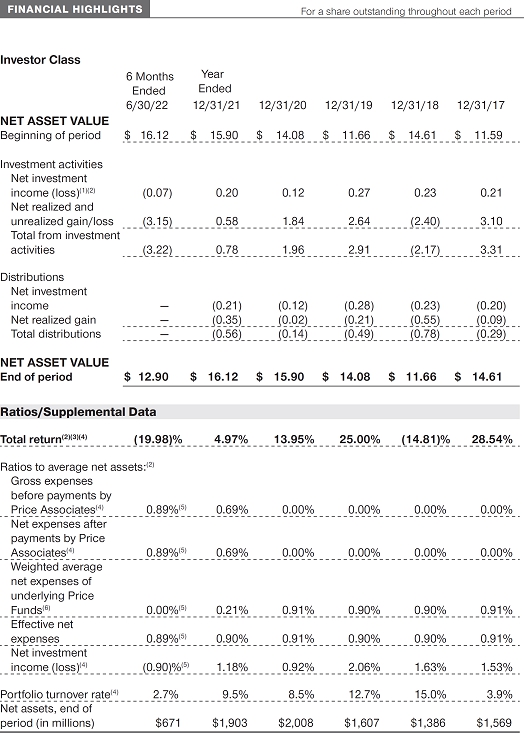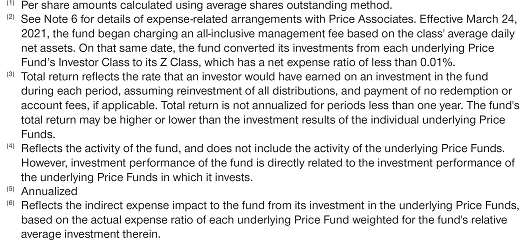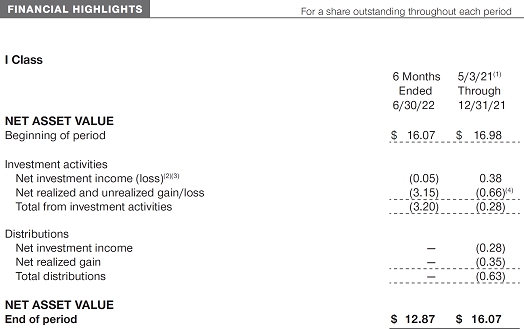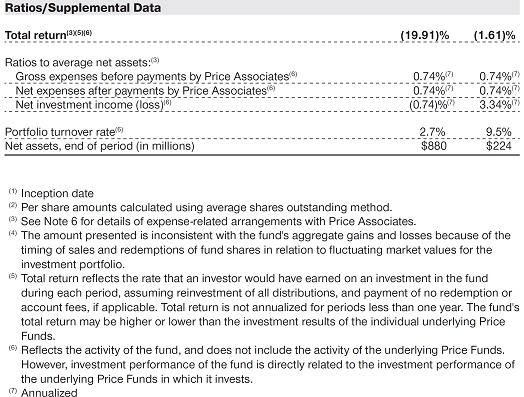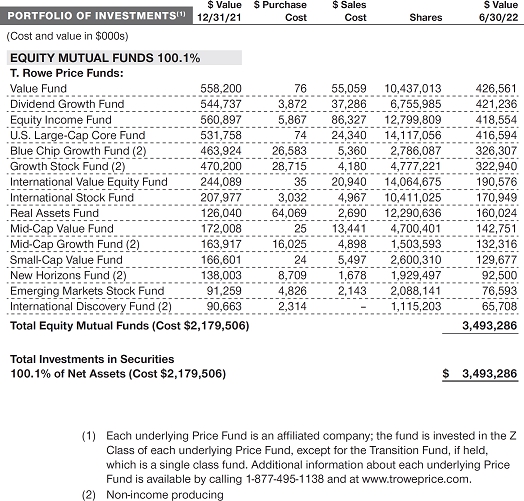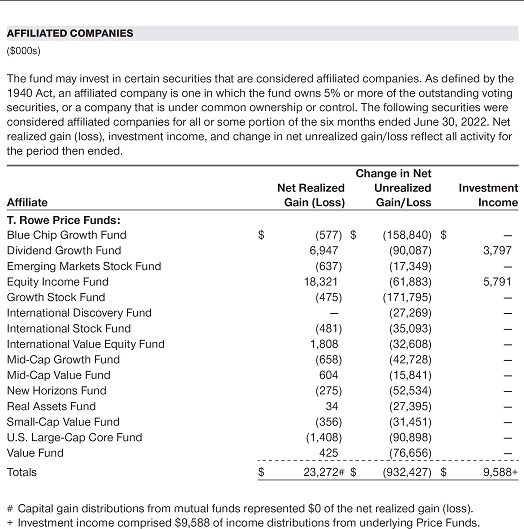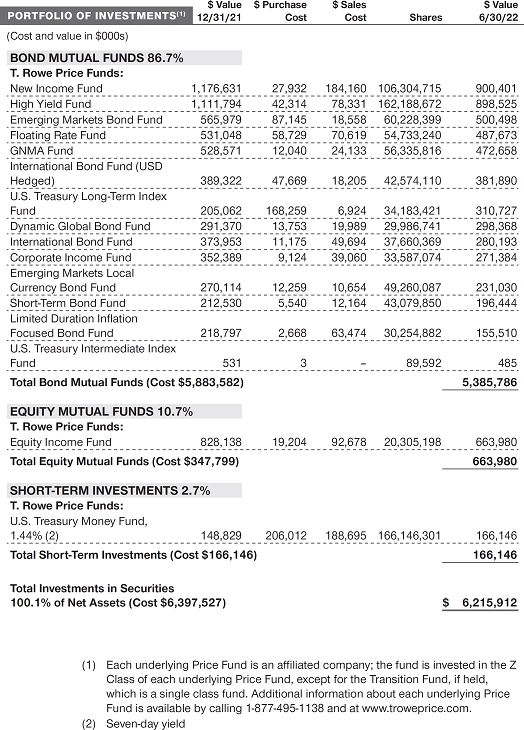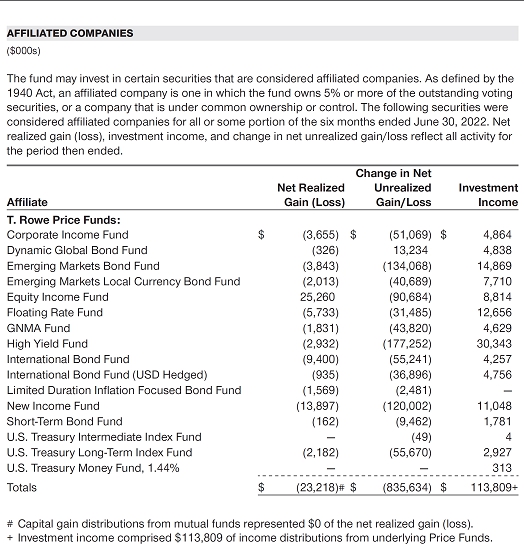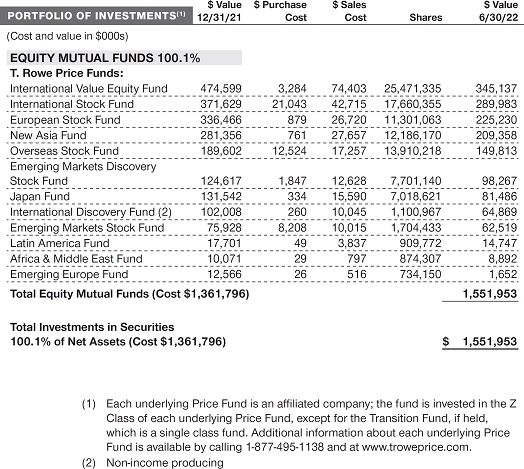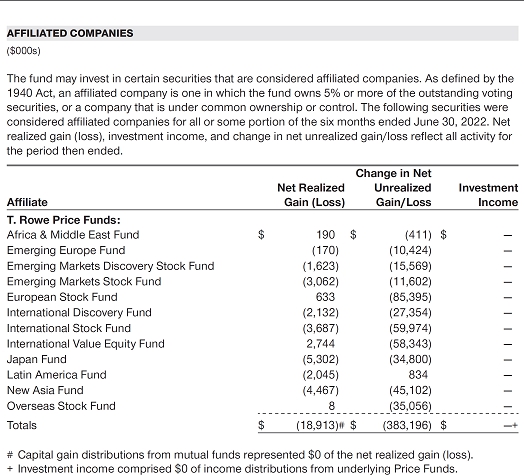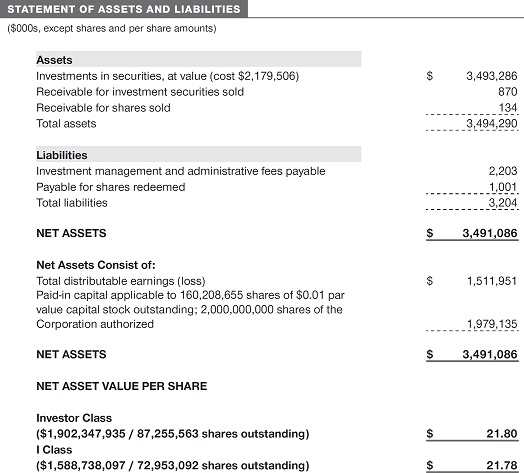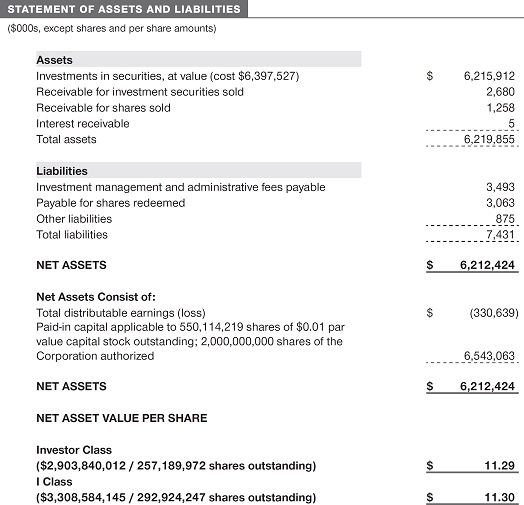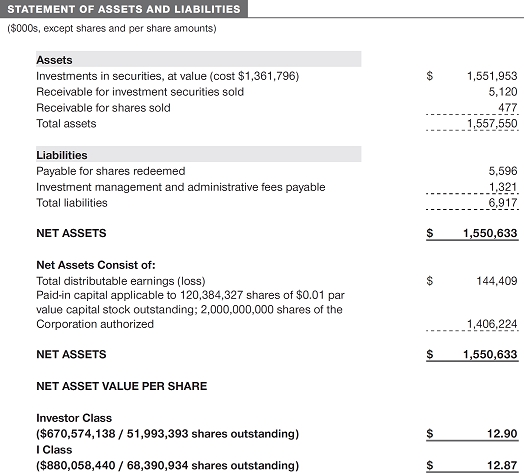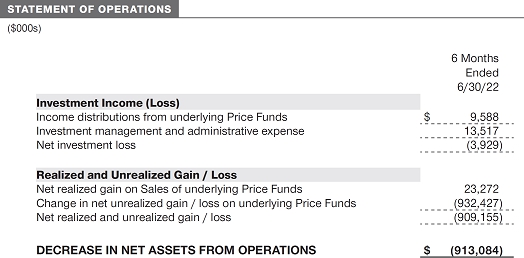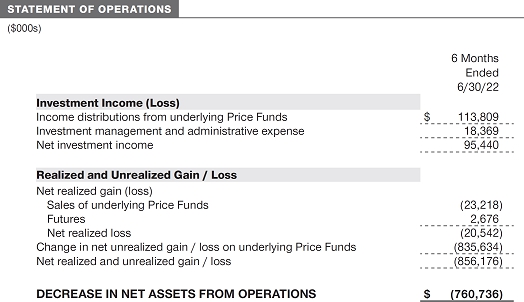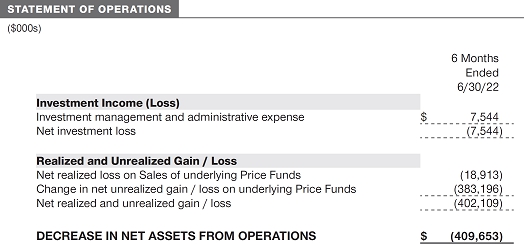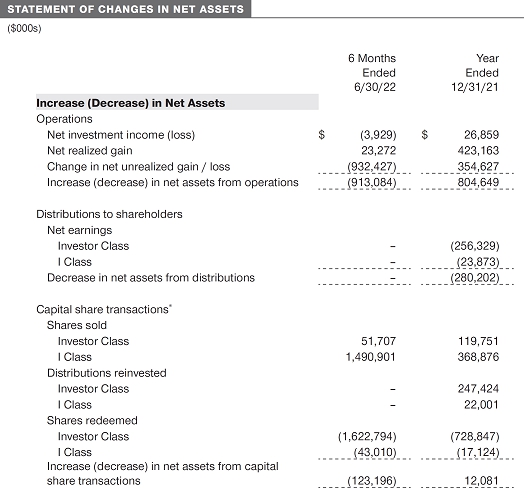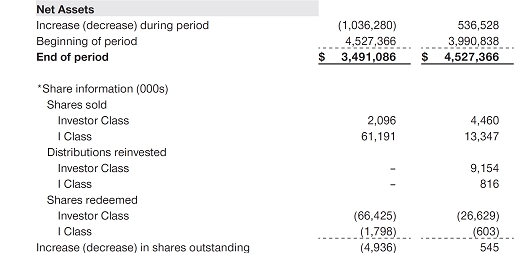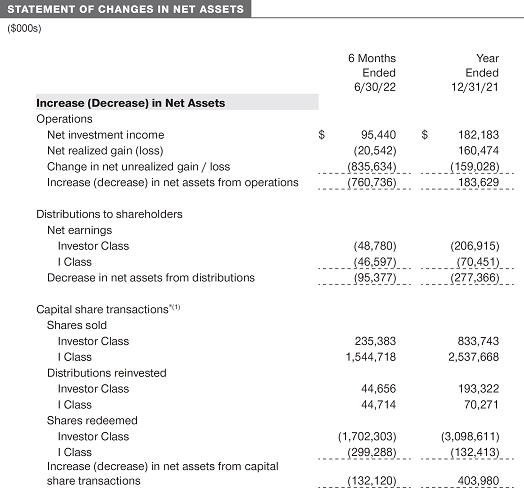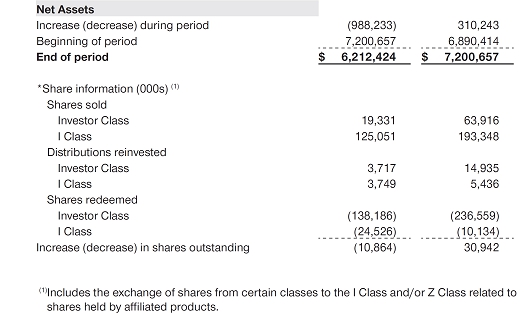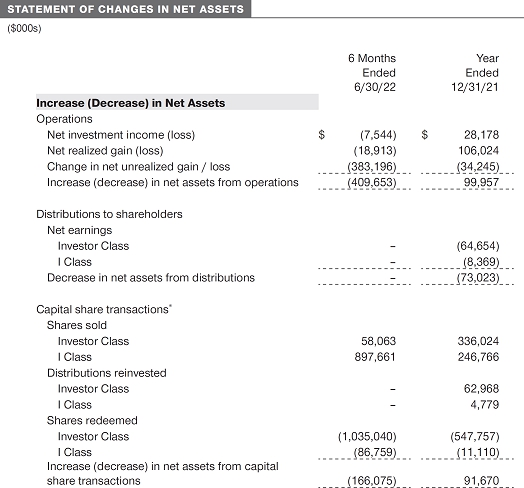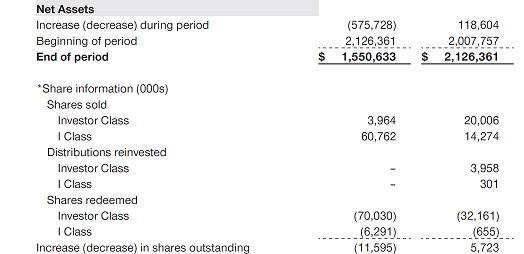UNITED STATES
SECURITIES AND EXCHANGE COMMISSION
Washington, D.C. 20549
FORM N-CSR
CERTIFIED SHAREHOLDER REPORT OF REGISTERED
MANAGEMENT INVESTMENT COMPANIES
Investment Company Act File Number: 811-04998
| T. Rowe Price Spectrum Fund, Inc. |
|
| (Exact name of registrant as specified in charter) |
| |
| 100 East Pratt Street, Baltimore, MD 21202 |
|
| (Address of principal executive offices) |
| |
| David Oestreicher |
| 100 East Pratt Street, Baltimore, MD 21202 |
|
| (Name and address of agent for service) |
Registrant’s telephone number, including area code: (410) 345-2000
Date of fiscal year end: December 31
Date of reporting period: June 30, 2022
Item 1. Reports to Shareholders
(a) Report pursuant to Rule 30e-1.
| Spectrum Funds | June 30, 2022 |
| PRSGX | Investor Class |
| TSVPX | I Class |
| RPSIX | Investor Class |
| TSPNX | I Class |
| PSILX | Investor Class |
| TSINX | I Class |
| T. ROWE PRICE SPECTRUM FUNDS |
|
HIGHLIGHTS
| ■ | The Spectrum Funds declined during the six-month period ended June 30, 2022. The Spectrum Diversified Equity Fund outpaced its benchmark, while the Spectrum Income Fund and Spectrum International Equity Fund both trailed their benchmarks. Performance relative to their respective Lipper peer benchmarks was mixed. |
| |
| ■ | Within the Spectrum Diversified Equity Fund and Spectrum International Equity Fund, we trimmed our overweight to value-oriented equities as cyclical tailwinds have weakened. For the Spectrum Income Fund, we are overweight to cash relative to bonds and dividend-paying equities. We also maintained an overweight to below investment-grade bonds. |
| |
| ■ | We expect a challenging economic and earnings environment, as persistent inflation and tightening monetary policy represent headwinds to growth and equity market returns. Other key risks to global markets include central bank missteps, elevated inflation, impacts of the Russia-Ukraine conflict, potential for a sharp slowdown in global growth, and China’s balance between containing COVID and growth. |
| |
| ■ | Given the uncertain impact of positive and negative forces driving global financial markets, we believe that the Spectrum Funds’ broad diversification and the strength of T. Rowe Price’s fundamental research platform should benefit our investors over time across a range of market and economic environments. |
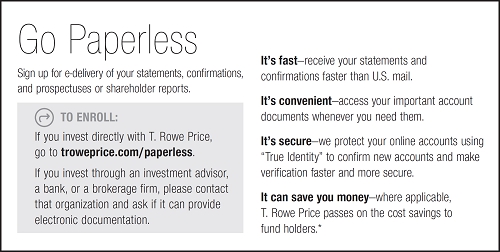
Log in to your account at troweprice.com for more information.
*Certain mutual fund accounts that are assessed an annual account service fee can also save money by switching to e-delivery.
Market Commentary
Dear Shareholder
Major stock and bond indexes produced sharply negative results during the first half of 2022 as investors contended with persistently high inflation, tightening financial conditions, and slowing growth.
After reaching an all-time high on January 3, the S&P 500 Index finished the period down about 20%, the worst first half of a calendar year for the index since 1970. Double-digit losses were common in equity markets around the globe, and bond investors also faced a historically tough environment amid a sharp rise in interest rates.
Value shares outperformed growth stocks as equity investors turned risk averse and rising rates put downward pressure on growth stock valuations. Emerging markets stocks held up somewhat better than shares in developed markets due to the strong performance of some oil-exporting countries. Meanwhile, the U.S. dollar strengthened during the period, which weighed on returns for U.S. investors in international securities.
Within the S&P 500, energy was the only bright spot, gaining more than 30% as oil prices jumped in response to Russia’s invasion of Ukraine and the ensuing commodity supply crunch. Typically defensive shares, such as utilities, consumer staples, and health care, finished in negative territory but held up relatively well. The consumer discretionary, communication services, and information technology sectors were the weakest performers. Shares of some major retailers fell sharply following earnings misses driven in part by overstocked inventories.
Inflation remained the leading concern for investors throughout the period. Despite hopes in 2021 that the problem was transitory, and later expectations that inflation would peak in the spring, headline consumer prices continued to grind higher throughout the first half of 2022. The war in Ukraine exacerbated already existing supply chain problems, and other factors, such as the impact of the fiscal and monetary stimulus enacted during the pandemic and strong consumer demand, also pushed prices higher. The May consumer price index report (the last to be issued during our reporting period) showed prices increasing 8.6% over the 12-month period, the largest jump since late 1981.
In response, the Federal Reserve, which at the end of 2021 had forecast that only three 25-basis-point (0.25 percentage point) rate hikes would be necessary in all of 2022, rapidly shifted in a hawkish direction and executed three rate increases in the first six months of the year. The policy moves included hikes of 25, 50, and 75 basis points—the largest single increase since 1994—increasing the central bank’s short-term lending benchmark from near zero to a target range of 1.50% to 1.75% by the end of June. In addition, the Fed ended the purchases of Treasuries and agency mortgage-backed securities that it had begun to support the economy early in the pandemic and started reducing its balance sheet in June.
Longer-term bond yields also increased considerably as the Fed tightened monetary policy, with the yield on the benchmark 10-year U.S. Treasury note reaching 3.49% on June 14, its highest level in more than a decade. (Bond prices and yields move in opposite directions.) Higher mortgage rates led to signs of cooling in the housing market.
The economy continued to add jobs during the period, and other indicators pointed to a slowing but still expanding economy. However, the University of Michigan consumer sentiment index dropped in June to its lowest level since records began in 1978 as higher inflation expectations undermined confidence.
Looking ahead, investors are likely to remain focused on whether the Fed can tame inflation without sending the economy into recession, a backdrop that could produce continued volatility. We believe this environment makes skilled active management a critical tool for identifying risks and opportunities, and our investment teams will continue to use fundamental research to identify companies that can add value to your portfolio over the long term.
Thank you for your continued confidence in T. Rowe Price.
Sincerely,
Robert Sharps
CEO and President
Management’s Discussion of Fund Performance
SPECTRUM DIVERSIFIED EQUITY FUND
INVESTMENT OBJECTIVE
The fund seeks long-term capital appreciation and growth of income with current income a secondary objective.
FUND COMMENTARY
How did the fund perform in the past six months?
The Spectrum Diversified Equity Fund returned -20.50% for the six-month period ended June 30, 2022, and outperformed its combined index portfolio, a custom-weighted benchmark composed of indexes that represent the asset classes in which the fund invests, as well as the Russell 3000 Index. The fund performed in line with its peer benchmark as represented by the Lipper Multi-Cap Core Funds Index. (Returns for the I Class will vary due to its different fee structure. Past performance cannot guarantee future results.)
What factors influenced the fund’s performance?
The Spectrum Diversified Equity Fund declined but outperformed its benchmark for the reporting period. Exposure to diversifying sectors not included in the fund’s benchmark contributed to relative performance. The inclusion of real assets equities boosted returns, although an underweight allocation partly offset the positive impact. Russia’s invasion of Ukraine in late February sparked supply concerns and drove elevated commodity prices even higher as both countries are major producers of various raw materials used globally. During the period, we closed our underweight to the real assets sector and are now neutral.
Tactical decisions also added value. Growth-oriented stocks sold off meaningfully in the first half of the year—pressured by high inflation and rising interest rates, which typically reduce the present value of their future earnings. Against this backdrop, our overweight allocation to U.S. large-cap value equities, which fared better than growth-oriented equities, proved beneficial. As discussed in the positioning section, we trimmed our overweight to value equities later in the period, as cyclical tailwinds that benefited the asset class have weakened.
In a volatile market environment characterized by uncertainty and fear, security selection detracted from relative performance. Our U.S. large-cap growth equity strategies, in particular, faced macroeconomic headwinds reflected in elevated inflation and rising interest rates. Higher-growth stocks suffered more meaningful losses—especially in the communication services, consumer discretionary, and information technology sectors. Bearish sentiment and indiscriminate selling has resulted in a disconnect between share prices and fundamentals in some cases, and we continue to be opportunistic and capitalize on select discounted opportunities that we believe will be rewarded once economic conditions improve. Our small-cap equity strategies also lagged their respective benchmarks and weighed on relative results. However, the negative impact was partly offset by security selection in our U.S. dividend-oriented equity strategies, led by stocks in the health care and financials sectors. Stock selection in the U.S. mid-cap and international developed growth equity strategies also added value, as these strategies outpaced their benchmarks.
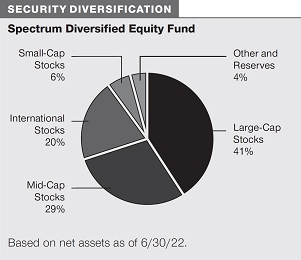
How is the fund positioned?
The Spectrum Diversified Equity Fund invests in several underlying T. Rowe Price funds that focus on U.S. and international equities across the full range of market capitalizations and styles, as well as in emerging markets.
We are modestly overweight to international stocks relative to U.S. stocks, most notably in emerging markets. The global growth outlook could benefit if economic growth expectations stabilize in China. However, inflation concerns, tighter central bank policies, and a prolonged war in Ukraine pose significant headwinds to the global economy. U.S. stocks are more growth oriented and are more susceptible to rising rates, but limited exposure to cyclical trends may prove beneficial should recession concerns worsen. Outside the U.S., we are overweight to emerging markets stocks relative to developed markets stocks given attractive valuations. While COVID-related lockdowns remain a near-term headwind in China, the prospects of significant policy support could boost the medium-term outlook.
In the U.S., we trimmed our overweight to value-oriented equities and added to our position in core equities. While value stock valuations remain relatively attractive, the gap has narrowed, and the cyclical outlook has weakened. The stay-at-home tailwind that benefited growth stocks continues to fade, and equity valuations could be pressured by higher rates. In a slowing economy with rising rates, core equities offer less cyclicality than value and less rate sensitivity with generally more attractive valuations than growth. We are overweight to U.S. small-cap stocks relative to larger companies, given attractive valuations as headwinds of a potential slowing economic environment are more fully priced into the sector. However, elevated input costs, wage pressures, and heightened market volatility could weigh on performance.
Among international equities, we reduced our overweight to value stocks relative to growth stocks. Growth stocks have higher relative valuations, and they face pressure not only from high inflation but also from rising interest rates. Meanwhile, value stocks are relatively attractive but are facing weaker cyclical tailwinds and heightened geopolitical risks. We are neutral between international small- and large-cap stocks. Small-caps balance idiosyncratic opportunities with moderating global growth, but caution is warranted due to U.S. dollar strength and a potential quality bias that could favor large-caps.
We added to inflation-sensitive real assets equities and are now neutral to the asset class, which may offer an attractive hedge should inflationary pressures persist longer, or settle higher, than expected. Although commodity valuations are elevated, geopolitical risks and supply shortages are likely to endure over the near to medium term. The real estate sector remains attractive but could be somewhat vulnerable to rising interest rates.
SPECTRUM INCOME FUND
INVESTMENT OBJECTIVE
The fund seeks a high level of current income with moderate share price fluctuation.
FUND COMMENTARY
How did the fund perform in the past six months?
The Spectrum Income Fund returned -10.77% for the six-month period ended June 30, 2022. The fund underperformed both the Bloomberg U.S. Aggregate Bond Index—which also declined meaningfully due to rising interest rates and returned -10.35%—as well as its peer Lipper Multi-Sector Income Funds Average benchmark. (Returns for the I Class will vary due to its different fee structure. Past performance cannot guarantee future results.)
What factors influenced the fund’s performance?
The Spectrum Income Fund lagged its benchmark for the period. Exposure to sectors and asset classes that are not included in the fund’s benchmark detracted from relative performance. Emerging markets bonds, in particular, were a notable negative contributor. Although our allocation benefited from a well-timed underweight allocation to Russia during the first quarter of 2022, returns suffered in the second quarter as risk-averse spillover effects from Russia’s invasion of Ukraine battered the asset class. Fears of a global recession—as persistent elevated inflation prompted hawkish actions from global central banks—were also a headwind. Exposure to high yield bonds also hurt results, although an allocation to floating rate loans proved beneficial. While high yield bonds have less sensitivity to rising interest rates than higher-quality issues, they fared poorly as credit spreads widened and investors were concerned about weaker corporate earnings and a possible recession. Security selection in the sector also detracted. Meanwhile, rising interest rates boosted floating rate loans, which outpaced investment-grade issues and high yield bonds. An overweight allocation to these loans also proved to be beneficial, though we trimmed our exposure on strength following a protracted run of strong returns.
The fund’s diversifying allocation to a fixed income absolute return-oriented strategy—which seeks to mitigate downside risk through a return profile with lower correlation to major asset classes—worked in our favor. In a period where most asset classes generated losses, this dynamic strategy bucked the trend with positive returns and significantly outperformed both equities and fixed income markets. The strategy also meaningfully outpaced its benchmark, lifted by favorable short duration positions that fared well against a backdrop of rising interest rates and higher inflation.
Tactical decisions contributed to relative performance. Equity and fixed income markets declined and posted double-digit losses during the reporting period as geopolitical conflict, persistent inflation, and rising interest rates weighed on sentiment. In this environment, an overweight allocation to cash aided returns. As previously discussed, an overweight to floating rate loans also added value. However, our underweight allocation to short-term bonds, which outperformed investment-grade bonds, detracted from relative performance.
Overall, security selection in our underlying strategies was positive. Our dividend-paying equity strategy outperformed its benchmark and contributed to relative results, led by holdings in the consumer discretionary and health care sectors. However, the positive impact was partly offset by our high yield bond and investment-grade bond strategies, which trailed their respective benchmarks for the period.
How is the fund positioned?
The Spectrum Income Fund invests primarily in fixed income securities through a diversified mix of U.S. and international T. Rowe Price mutual funds. Underlying investments also include a fund focused on dividend-paying U.S. large-cap stocks.
We maintained an overweight to below investment-grade bonds, moderating our overweight to floating rate loans and adding to high yield bonds. We increased our overweight to high yield bonds given attractive yield and spread levels. High yield credit fundamentals are still strong, default risk remains low, and elevated commodity prices are supportive. We believe that, in an environment of challenged equity returns, high yield bonds offer a compelling risk-adjusted return profile. Additionally, exposure to the energy sector, which makes up a significant portion of the high yield sector, should be beneficial. Conversely, interest rate sensitivity as well as geopolitical, inflationary, and growth concerns are likely to continue driving credit spread volatility.
We pared our overweight to floating rate bank loans on strength after significant appreciation in the first half of the year. Although we remain constructive on loans due to their higher coupons as the Fed continues to raise interest rates, we are cautious of new issuance quality. Bank loans have also recently suffered from investor outflows, poor liquidity, and recession concerns. In our view, the asset class is still supported by solid fundamentals and demand for yield, although their shorter-duration profile and rate reset feature may be less beneficial as tighter monetary policy appears to be priced in.
We are underweight to hedged nondollar bonds as prices could be pressured by rising interest rates. Short-term rates are expected to trend higher with major central banks tightening, while long-term rates are reacting to persistent inflation pressures and renewed concerns about growth and policy missteps. We are overweight to nondollar bonds as the sector provides potential yield curve diversification, particularly given the differing paces with which various central banks are progressing with monetary policy tightening. While near-term risks remain that the U.S. dollar could strengthen further in a risk-off environment, we believe nondollar bonds should benefit from more supportive currency dynamics over the intermediate term given narrowing growth and real interest rate differentials.
We increased our exposure and are now overweight to dollar-denominated emerging markets bonds given attractive valuations and a growing number of idiosyncratic opportunities. However, geopolitical tensions, lingering coronavirus concerns, and fiscal pressures remain risks against the backdrop of higher U.S. interest rates and a stronger U.S. dollar. We are overweight to emerging markets local currency bonds, as yields are at attractive levels. Many emerging markets are further along in tightening monetary policy, with higher domestic rates and higher yields than developed markets, although the sector remains vulnerable to Fed policy changes. In addition, recent market volatility has resulted in attractively valued currencies. We expect the sector to benefit from peaking inflation and fewer rate hikes over the intermediate term.
We closed our underweight to long-term U.S. Treasury bonds and are now neutral following recent moves higher in rates to provide a potential hedge against further equity market volatility. As the Fed remains steadfast in its path to raise rates and long-run inflation expectations moderate, we believe that further moves higher in the long end of the curve could be more modest. However, long-term Treasuries remain vulnerable to a further rise in yields should elevated inflation persist longer than expected.
We are modestly underweight to dividend-paying equities. Despite the steep sell-off year-to-date, equities are vulnerable to further weakness. Although earnings expectations have held up reasonably well so far, they could be pressured by rising input costs and slowing economic growth.
SPECTRUM INTERNATIONAL EQUITY FUND
INVESTMENT OBJECTIVE
The fund seeks long-term capital appreciation.
FUND COMMENTARY
How did the fund perform in the past six months?
The Spectrum International Equity Fund returned -19.98% for the six-month period ended June 30, 2022. The fund underperformed the MSCI All Country World Index ex USA Net, as well as its peer Lipper International Multi-Cap Core Funds Average benchmark. (Returns for the I Class will vary due to its different fee structure. Past performance cannot guarantee future results.)
What factors influenced the fund’s performance?
During the reporting period, the Spectrum International Equity Fund lagged its benchmark. Within the underlying strategies, the European Stock Fund was a notable detractor. European equities fell as gas shortages, supply chain disruptions, inflation, low consumer confidence, and recessionary fears weighed on companies and investor sentiment. Within the fund, stock selection and an overweight allocation to the industrials and business services sector hurt relative returns. Lack of exposure to the strong-performing energy sector also detracted. Companies levered to energy produced significant gains as oil and natural gas prices climbed to multiyear highs after Russia’s invasion of Ukraine triggered global supply concerns. Among the countries in the region, names in the UK and Germany detracted the most.
The Japan Fund also underperformed its benchmark and weighed on relative results. A quality bias and a cyclical rally in value stocks was a considerable headwind. Further, a stronger U.S. dollar, recession fears sparked by the U.S. Federal Reserve’s steep interest rate hike, along with monetary policy moves by other major central banks also weighed on sentiment. Within the fund, stock selection in the industrials and business services and information technology sectors was a drag. We believe the recent pressure on equities has created an opportunity for long-term investors. Despite the ongoing uncertainty in the global economy, Japanese companies continue to buy back stock and return capital to shareholders at record levels—an encouraging sign on the health of these corporations and the ongoing improvement in the country’s corporate governance. In the International Discovery Fund, names in the health care sector detracted, while the International Value Fund and the New Asia Fund also trailed their benchmarks, weighed down by holdings in the information technology sector.
Conversely, the International Stock Fund outperformed its benchmark and contributed to relative performance. Overall, international equity markets posted losses during the period, as worries surrounding the war in Ukraine, ongoing COVID lockdowns in China, inflation and rising interest rates, supply chain shortages, and recession combined to push markets materially lower. However, positive security selection in the fund boosted returns as our holdings in the aerospace and defense industry rose after Russia’s invasion of Ukraine drove expectations for higher defense spending, especially within Europe. Names in the semiconductors and semiconductor equipment industry also added value. On a regional basis, holdings in developed Europe, especially in France, were among the best performers.
How is the fund positioned?
The Spectrum International Equity Fund offers investors broadly diversified exposure to international equities in developed and emerging markets.
We continue to be overweight to emerging markets stocks, which offer more compelling valuations relative to developed markets stocks, in our view. Pandemic-related lockdowns remain a near-term headwind in China, but the prospects of more significant policy support could boost the intermediate-term outlook for emerging markets broadly. Additionally, China’s reopening economy is likely to be supportive as lockdowns and travel restrictions are lifted. Multiple risks persist in China, including the country’s zero-COVID policy, default risks in the property sector, social policy, and sanction-related impacts. However, in our view, markets have already adjusted to many of these risks.
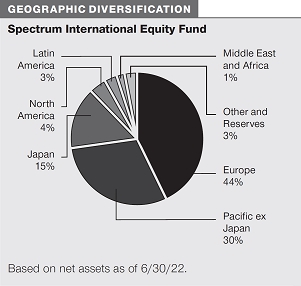
Among developed markets, we are overweight to Japanese equities given attractive relative valuations. Although geopolitical risks and yen weakness have weighed on the region, we believe supportive monetary policy is likely to benefit Japanese stocks. In addition, improving corporate governance and focus on shareholder-oriented reforms could provide a catalyst to value realization over the longer term.
We are underweight to European equities. While more cyclically oriented European equities offer reasonable valuations, the Russia’s ongoing assault on Ukraine poses a significant risk due to rising energy costs and the impact of financial sanctions. Additionally, support from the European Central Bank is likely to fade in the near term.
We reduced our overweight to value stocks relative to growth stocks. Growth stocks have higher relative valuations, and they face pressure not only from high inflation but also from rising interest rates. Meanwhile, value stocks are relatively attractive but are facing weaker cyclical tailwinds and heightened geopolitical risks.
What is portfolio management’s outlook for the Spectrum Funds?
Global equity and bond markets were volatile during the first half of 2022, as stubbornly high inflation and rising interest rates continued to weigh on financial markets. The level of uncertainty in global markets remains high, and the ongoing war in Ukraine has exacerbated these risks. With inflation at multi-decade highs, the Fed has made fighting inflation its top priority, and central bank officials intend to pursue an aggressive pace of tightening to achieve their goal. The key question is whether the Fed and other major central banks will be able to tame inflation without stifling economic growth and causing a recession. While there have been signs in some markets that price pressures may be easing, inflation will probably settle at uncomfortably high levels, likely above the Fed’s 2% long-term inflation target in a post‐pandemic environment.
We expect a challenging economic and earnings environment, as persistent inflation and tightening monetary policy represent headwinds to growth and equity market returns. Given the range of potential paths for growth and inflation, our positioning remains cautious as we seek to hedge against more extreme outcomes like stagflation and recession. Other key risks to global markets include central bank missteps, elevated inflation, impacts of the Russia-Ukraine conflict, potential for a sharp slowdown in global growth, and China’s balance between containing COVID and growth. In our view, these conditions contribute to a less compelling risk/reward trade-off between stocks and bonds in the near term, and we believe that a more modest allocation to equities may be prudent. In a dynamic market, we continue to assess when to add to equities, as we evaluate attractive long‐term valuations and early indications of stabilization or improvement in macroeconomic conditions.
The elevated levels of volatility and uncertainty in global markets underscore the value of our thoughtful strategic investing approach. Given the uncertain impact of positive and negative forces driving global financial markets, we believe that the Spectrum Funds’ broad diversification and the strength of T. Rowe Price’s fundamental research platform should benefit our investors over time across a range of market and economic environments.
The views expressed reflect the opinions of T. Rowe Price as of the date of this report and are subject to change based on changes in market, economic, or other conditions. These views are not intended to be a forecast of future events and are no guarantee of future results.
RISKS OF INVESTING
As with all stock and bond mutual funds, each fund’s share price can fall because of weakness in the stock or bond markets, a particular industry, or specific holdings. Stock markets can decline for many reasons, including adverse political or economic developments, changes in investor psychology, or heavy institutional selling. The prospects for an industry or company may deteriorate because of a variety of factors, including disappointing earnings or changes in the competitive environment. In addition, the investment manager’s assessment of companies held in a fund may prove incorrect, resulting in losses or poor performance even in rising markets.
Bonds are subject to interest rate risk, the decline in bond prices that usually accompanies a rise in interest rates, and credit risk, the chance that any fund holding could have its credit rating downgraded or that a bond issuer will default (fail to make timely payments of interest or principal), potentially reducing the fund’s income level and share price. High yield corporate bonds could have greater price declines than funds that invest primarily in high-quality bonds. Companies issuing high yield bonds are not as strong financially as those with higher credit ratings, so the bonds are usually considered speculative investments.
Funds that invest overseas may carry more risk than funds that invest strictly in U.S. assets. Risks can result from varying stages of economic and political development; differing regulatory environments, trading days, and accounting standards; and higher transaction costs of non-U.S. markets. Non-U.S. investments are also subject to currency risk, or a decline in the value of a foreign currency versus the U.S. dollar, which reduces the dollar value of securities denominated in that currency.
For a thorough discussion of risks, please see each fund’s prospectus.
BENCHMARK INFORMATION
Combined index portfolio: An unmanaged blended index portfolio created as a custom benchmark for the Spectrum Diversified Equity Fund consisting of 70% Russell 3000 Index and 30% MSCI All Country World ex-USA IMI.
Note: Bloomberg® and Bloomberg U.S. Aggregate Bond Index are service marks of Bloomberg Finance L.P. and its affiliates, including Bloomberg Index Services Limited (“BISL”), the administrator of the index (collectively, “Bloomberg”) and have been licensed for use for certain purposes by T. Rowe Price. Bloomberg is not affiliated with T. Rowe Price, and Bloomberg does not approve, endorse, review, or recommend its products. Bloomberg does not guarantee the timeliness, accurateness, or completeness of any data or information relating to its products.
Note: Portions of the mutual fund information contained in this report was supplied by Lipper, a Refinitiv Company, subject to the following: Copyright 2022 © Refinitiv. All rights reserved. Any copying, republication or redistribution of Lipper content is expressly prohibited without the prior written consent of Lipper. Lipper shall not be liable for any errors or delays in the content, or for any actions taken in reliance thereon.
Note: MSCI and its affiliates and third-party sources and providers (collectively, “MSCI”) makes no express or implied warranties or representations and shall have no liability whatsoever with respect to any MSCI data contained herein. The MSCI data may not be further redistributed or used as a basis for other indices or any securities or financial products. This report is not approved, reviewed, or produced by MSCI. Historical MSCI data and analysis should not be taken as an indication or guarantee of any future performance analysis, forecast or prediction. None of the MSCI data is intended to constitute investment advice or a recommendation to make (or refrain from making) any kind of investment decision and may not be relied on as such.
Note: London Stock Exchange Group plc and its group undertakings (collectively, the “LSE Group”). © LSE Group 2022. All rights in the FTSE Russell indexes or data vest in the relevant LSE Group company which owns the index or the data. Neither LSE Group nor its licensors accept any liability for any errors or omissions in the indexes or data and no party may rely on any indexes or data contained in this communication. No further distribution of data from the LSE Group is permitted without the relevant LSE Group company’s express written consent. The LSE Group does not promote, sponsor or endorse the content of this communication.
GROWTH OF $10,000
This chart shows the value of a hypothetical $10,000 investment in the fund over the past 10 fiscal year periods or since inception (for funds lacking 10-year records). The result is compared with benchmarks, which include a broad-based market index and may also include a peer group average or index. Market indexes do not include expenses, which are deducted from fund returns as well as mutual fund averages and indexes.
AVERAGE ANNUAL COMPOUND TOTAL RETURN
GROWTH OF $10,000
This chart shows the value of a hypothetical $10,000 investment in the fund over the past 10 fiscal year periods or since inception (for funds lacking 10-year records). The result is compared with benchmarks, which include a broad-based market index and may also include a peer group average or index. Market indexes do not include expenses, which are deducted from fund returns as well as mutual fund averages and indexes.
AVERAGE ANNUAL COMPOUND TOTAL RETURN
GROWTH OF $10,000
This chart shows the value of a hypothetical $10,000 investment in the fund over the past 10 fiscal year periods or since inception (for funds lacking 10-year records). The result is compared with benchmarks, which include a broad-based market index and may also include a peer group average or index. Market indexes do not include expenses, which are deducted from fund returns as well as mutual fund averages and indexes.
AVERAGE ANNUAL COMPOUND TOTAL RETURN
EXPENSE RATIO
FUND EXPENSE EXAMPLE
As a mutual fund shareholder, you may incur two types of costs: (1) transaction costs, such as redemption fees or sales loads, and (2) ongoing costs, including management fees, distribution and service (12b-1) fees, and other fund expenses. The following example is intended to help you understand your ongoing costs (in dollars) of investing in the fund and to compare these costs with the ongoing costs of investing in other mutual funds. The example is based on an investment of $1,000 invested at the beginning of the most recent six-month period and held for the entire period.
Please note that the fund has two share classes: The original share class (Investor Class) charges no distribution and service (12b-1) fee, and the I Class shares are also available to institutionally oriented clients and impose no 12b-1 or administrative fee payment. Each share class is presented separately in the table.
Actual Expenses
The first line of the following table (Actual) provides information about actual account values and expenses based on the fund’s actual returns. You may use the information on this line, together with your account balance, to estimate the expenses that you paid over the period. Simply divide your account value by $1,000 (for example, an $8,600 account value divided by $1,000 = 8.6), then multiply the result by the number on the first line under the heading “Expenses Paid During Period” to estimate the expenses you paid on your account during this period.
Hypothetical Example for Comparison Purposes
The information on the second line of the table (Hypothetical) is based on hypothetical account values and expenses derived from the fund’s actual expense ratio and an assumed 5% per year rate of return before expenses (not the fund’s actual return). You may compare the ongoing costs of investing in the fund with other funds by contrasting this 5% hypothetical example and the 5% hypothetical examples that appear in the shareholder reports of the other funds. The hypothetical account values and expenses may not be used to estimate the actual ending account balance or expenses you paid for the period.
Note: T. Rowe Price charges an annual account service fee of $20, generally for accounts with less than $10,000. The fee is waived for any investor whose T. Rowe Price mutual fund accounts total $50,000 or more; accounts electing to receive electronic delivery of account statements, transaction confirmations, prospectuses, and shareholder reports; or accounts of an investor who is a T. Rowe Price Personal Services or Enhanced Personal Services client (enrollment in these programs generally requires T. Rowe Price assets of at least $250,000). This fee is not included in the accompanying table. If you are subject to the fee, keep it in mind when you are estimating the ongoing expenses of investing in the fund and when comparing the expenses of this fund with other funds.
You should also be aware that the expenses shown in the table highlight only your ongoing costs and do not reflect any transaction costs, such as redemption fees or sales loads. Therefore, the second line of the table is useful in comparing ongoing costs only and will not help you determine the relative total costs of owning different funds. To the extent a fund charges transaction costs, however, the total cost of owning that fund is higher.
| T. ROWE PRICE SPECTRUM DIVERSIFIED EQUITY FUND |
|
Unaudited
The accompanying notes are an integral part of these financial statements.
Unaudited
The accompanying notes are an integral part of these financial statements.
| T. ROWE PRICE SPECTRUM INCOME FUND |
|
Unaudited
The accompanying notes are an integral part of these financial statements.
Unaudited
The accompanying notes are an integral part of these financial statements.
| T. ROWE PRICE SPECTRUM INTERNATIONAL EQUITY FUND |
|
Unaudited
The accompanying notes are an integral part of these financial statements.
Unaudited
The accompanying notes are an integral part of these financial statements.
| T. ROWE PRICE SPECTRUM DIVERSIFIED EQUITY FUND |
|
June 30, 2022 (Unaudited)
The accompanying notes are an integral part of these financial statements.
| T. ROWE PRICE SPECTRUM INCOME FUND |
|
June 30, 2022 (Unaudited)
The accompanying notes are an integral part of these financial statements.
| T. ROWE PRICE SPECTRUM INTERNATIONAL EQUITY FUND |
|
June 30, 2022 (Unaudited)
The accompanying notes are an integral part of these financial statements.
| T. ROWE PRICE SPECTRUM DIVERSIFIED EQUITY FUND |
|
June 30, 2022 (Unaudited)
The accompanying notes are an integral part of these financial statements.
| T. ROWE PRICE SPECTRUM INCOME FUND |
|
June 30, 2022 (Unaudited)
The accompanying notes are an integral part of these financial statements.
| T. ROWE PRICE SPECTRUM INTERNATIONAL EQUITY FUND |
|
June 30, 2022 (Unaudited)
The accompanying notes are an integral part of these financial statements.
| T. ROWE PRICE SPECTRUM DIVERSIFIED EQUITY FUND |
|
Unaudited
The accompanying notes are an integral part of these financial statements.
| T. ROWE PRICE SPECTRUM INCOME FUND |
|
Unaudited
The accompanying notes are an integral part of these financial statements.
| T. ROWE PRICE SPECTRUM INTERNATIONAL EQUITY FUND |
|
Unaudited
The accompanying notes are an integral part of these financial statements.
| T. ROWE PRICE SPECTRUM DIVERSIFIED EQUITY FUND |
|
Unaudited
The accompanying notes are an integral part of these financial statements.
| T. ROWE PRICE SPECTRUM INCOME FUND |
|
Unaudited
The accompanying notes are an integral part of these financial statements.
| T. ROWE PRICE SPECTRUM INTERNATIONAL EQUITY FUND |
|
Unaudited
The accompanying notes are an integral part of these financial statements.
| T. ROWE PRICE SPECTRUM FUNDS |
|
Unaudited
| NOTES TO FINANCIAL STATEMENTS |
T. Rowe Price Spectrum Fund, Inc. (the corporation) is registered under the Investment Company Act of 1940 (the 1940 Act). Spectrum Diversified Equity Fund, Spectrum Income Fund, and Spectrum International Equity Fund (collectively, the Spectrum Funds) are diversified open-end management investment companies established by the corporation. Each Spectrum Fund broadly diversifies its assets within specified ranges among a set of T. Rowe Price mutual funds (underlying Price Funds) representing specific market segments. Spectrum Diversified Equity seeks long-term capital appreciation and growth of income with current income as a secondary objective. Spectrum Income seeks a high level of current income with moderate share price fluctuation. Spectrum International Equity seeks long-term capital appreciation.
Each fund has two classes of shares as follows: Spectrum Diversified Equity Fund (Investor Class) and Spectrum Diversified Equity Fund – I Class (I Class); Spectrum Income Fund (Investor Class) and Spectrum Income Fund – I Class (I Class); and Spectrum International Equity Fund (Investor Class) and Spectrum International Equity Fund – I Class (I Class). I Class shares require a $500,000 initial investment minimum, although the minimum generally is waived or reduced for financial intermediaries, eligible retirement plans and certain other accounts. Prior to November 15, 2021, the initial investment minimum was $1 million and was generally waived for financial intermediaries, eligible retirement plans, and other certain accounts. Each class has exclusive voting rights on matters related solely to that class; separate voting rights on matters that relate to both classes; and, in all other respects, the same rights and obligations as the other class.
NOTE 1 - SIGNIFICANT ACCOUNTING POLICIES
Basis of Preparation Each fund is an investment company and follows accounting and reporting guidance in the Financial Accounting Standards Board Accounting Standards Codification Topic 946 (ASC 946). The accompanying financial statements were prepared in accordance with accounting principles generally accepted in the United States of America (GAAP), including, but not limited to, ASC 946. GAAP requires the use of estimates made by management. Management believes that estimates and valuations of the underlying Price Funds are appropriate; however, actual results may differ from those estimates, and the valuations reflected in the accompanying financial statements may differ from the value ultimately realized upon sale of the underlying Price Funds.
Investment Transactions, Investment Income, and Distributions Investment transactions are accounted for on the trade date basis. Income and expenses are recorded on the accrual basis. Realized gains and losses are reported on the identified cost basis. Income tax-related interest and penalties, if incurred, are recorded as income tax expense. Dividends received from underlying Price Fund investments are reflected as dividend income; capital gain distributions are reflected as realized gain/loss. Income and capital gain distributions from the underlying Price Funds are recorded on the ex-dividend date. Distributions to shareholders are recorded on the ex-dividend date. Income distributions are declared by Spectrum Income daily and paid monthly. Income distributions, if any, are declared and paid by Spectrum Diversified Equity and Spectrum International Equity annually. A capital gain distribution may also be declared and paid by each fund annually.
Class Accounting Investment management and administrative expenses incurred by each class are charged directly to the class to which they relate. Expenses common to all classes, income distributions from the underlying Price Funds, and realized and unrealized gains and losses are allocated to the classes based upon the relative daily net assets of each class.
Capital Transactions Each investor’s interest in the net assets of each fund is represented by fund shares. Each fund’s net asset value (NAV) per share is computed at the close of the New York Stock Exchange (NYSE), normally 4 p.m. ET, each day the NYSE is open for business. However, the NAV per share may be calculated at a time other than the normal close of the NYSE if trading on the NYSE is restricted, if the NYSE closes earlier, or as may be permitted by the SEC. Purchases and redemptions of fund shares are transacted at the next-computed NAV per share, after receipt of the transaction order by T. Rowe Price Associates, Inc., or its agents.
Indemnification In the normal course of business, the funds may provide indemnification in connection with its officers and directors, service providers, and/or private company investments. Each fund’s maximum exposure under these arrangements is unknown; however, the risk of material loss is currently considered to be remote.
NOTE 2 - VALUATION
Each fund’s financial instruments are valued at the close of the NYSE and are reported at fair value, which GAAP defines as the price that would be received to sell an asset or paid to transfer a liability in an orderly transaction between market participants at the measurement date. Investments in the underlying Price Funds are valued at their closing NAV per share on the day of valuation. Assets and liabilities other than financial instruments, including short-term receivables and payables, are carried at cost, or estimated realizable value, if less, which approximates fair value.
The T. Rowe Price Valuation Committee (the Valuation Committee) is an internal committee that has been delegated certain responsibilities by the funds’ Board of Directors (the Board) to ensure that financial instruments are appropriately priced at fair value in accordance with GAAP and the 1940 Act. Subject to oversight by the Board, the Valuation Committee develops and oversees pricing-related policies and procedures and approves all fair value determinations. Specifically, the Valuation Committee establishes policies and procedures used in valuing financial instruments; determines pricing techniques, sources, and persons eligible to effect fair value pricing actions; evaluates the service and performance of the pricing vendors; oversees the pricing process to ensure policies and procedures are being followed; and provides guidance on internal controls and valuation-related matters. The Valuation Committee provides periodic reporting to the Board on valuation matters.
Various valuation techniques and inputs are used to determine the fair value of financial instruments. GAAP establishes the following fair value hierarchy that categorizes the inputs used to measure fair value:
Level 1 – quoted prices (unadjusted) in active markets for identical financial instruments that the fund can access at the reporting date
Level 2 – inputs other than Level 1 quoted prices that are observable, either directly or indirectly (including, but not limited to, quoted prices for similar financial instruments in active markets, quoted prices for identical or similar financial instruments in inactive markets, interest rates and yield curves, implied volatilities, and credit spreads)
Level 3 – unobservable inputs (including the fund’s own assumptions in determining fair value)
Observable inputs are developed using market data, such as publicly available information about actual events or transactions, and reflect the assumptions that market participants would use to price the financial instrument. Unobservable inputs are those for which market data are not available and are developed using the best information available about the assumptions that market participants would use to price the financial instrument. GAAP requires valuation techniques to maximize the use of relevant observable inputs and minimize the use of unobservable inputs. When multiple inputs are used to derive fair value, the financial instrument is assigned to the level within the fair value hierarchy based on the lowest-level input that is significant to the fair value of the financial instrument. Input levels are not necessarily an indication of the risk or liquidity associated with financial instruments at that level but rather the degree of judgment used in determining those values. On June 30, 2022, all of the fund’s financial instruments were classified as Level 1, based on the inputs used to determine their fair values.
NOTE 3 - DERIVATIVE INSTRUMENTS
The funds may use derivatives in an effort to manage cash flows efficiently, remain fully invested, or facilitate asset allocation and rebalancing. As defined by GAAP, a derivative is a financial instrument whose value is derived from an underlying security price, foreign exchange rate, interest rate, index of prices or rates, or other variable; it requires little or no initial investment and permits or requires net settlement. The funds invest in derivatives only if the expected risks and rewards are consistent with its investment objectives, policies, and overall risk profile, as described in its prospectus and Statement of Additional Information. The risks associated with the use of derivatives are different from, and potentially much greater than, the risks associated with investing directly in the instruments on which the derivatives are based. The funds at all times maintain sufficient cash reserves, liquid assets, or other SEC-permitted asset types to cover their settlement obligations under open derivative contracts.
The funds value their derivatives at fair value and recognizes changes in fair value currently in their results of operations. Accordingly, the funds do not follow hedge accounting, even for derivatives employed as economic hedges. Generally, the funds account for their derivatives on a gross basis. They do not offset the fair value of derivative liabilities against the fair value of derivative assets on their financial statements, nor do they offset the fair value of derivative instruments against the right to reclaim or obligation to return collateral. As of June 30, 2022, the Spectrum Diversified Equity Fund, Spectrum Income Fund and Spectrum International Equity Fund held no derivative instruments.
The amount of gains and losses on futures recognized in fund earnings during the six months ended June 30, 2022, and the related location on the accompanying Statement of Operations is summarized in the following table by primary underlying risk exposure:
Spectrum Income Fund

Futures Contracts A futures contract provides for the future sale by one party and purchase by another of a specified amount of a specific underlying financial instrument at an agreed upon price, date, time, and place. The funds currently invest only in exchange-traded futures, which generally are standardized as to maturity date, underlying financial instrument, and other contract terms. Payments are made or received by the fund each day to settle daily fluctuations in the value of the contract (variation margin), which reflect changes in the value of the underlying financial instrument. Variation margin is recorded as unrealized gain or loss until the contract is closed. The value of a futures contract included in net assets is the amount of unsettled variation margin; net variation margin receivable is reflected as an asset and net variation margin payable is reflected as a liability on the accompanying Statement of Assets and Liabilities. Risks related to the use of futures contracts include possible illiquidity of the futures markets, contract prices that can be highly volatile and imperfectly correlated to movements in hedged security values, and potential losses in excess of the fund’s initial investment. During the six months ended June 30, 2022, the volume of the activity in futures, based on underlying notional amounts, was generally less than 1% for the Spectrum Income Fund.
NOTE 4 - INVESTMENTS IN UNDERLYING PRICE FUNDS
Purchases and sales of the underlying Price Funds during the six months ended June 30, 2022, were as follows:
NOTE 5 - FEDERAL INCOME TAXES
No provision for federal income taxes is required since each fund intends to continue to qualify as a regulated investment company under Subchapter M of the Internal Revenue Code and distribute to shareholders all of its taxable income and gains. Distributions determined in accordance with federal income tax regulations may differ in amount or character from net investment income and realized gains for financial reporting purposes. Financial reporting records are adjusted for permanent book/tax differences to reflect tax character but are not adjusted for temporary differences. The amount and character of tax-basis distributions and composition of net assets are finalized at fiscal year-end; accordingly, tax-basis balances have not been determined as of the date of this report.
Each fund intends to retain realized gains to the extent of available capital loss carryforwards. Net realized capital losses may be carried forward indefinitely to offset future realized capital gains. As of December 31, 2021, Spectrum Diversified Equity had no available capital loss carryforwards, Spectrum Income had $331,000 of available capital loss carryforwards, and Spectrum International Equity had no available capital loss carryforwards.
At June 30, 2022, the cost of investments for federal income tax purposes and net unrealized gain (loss) on investments was as follows:
NOTE 6 - RELATED PARTY TRANSACTIONS
The Spectrum Funds are managed by T. Rowe Price Associates, Inc. (Price Associates), a wholly owned subsidiary of T. Rowe Price Group, Inc. Price Associates, directly or through sub-advisory agreements with its wholly owned subsidiaries, also provides investment management services to all the underlying Price Funds. Pursuant to various service agreements, Price Associates and its wholly owned subsidiaries provide shareholder servicing and administrative services as well as certain accounting, marketing, and other services to the Spectrum Funds. Certain officers and directors of the Spectrum Funds are also officers and directors of Price Associates and its subsidiaries and of the underlying Price Funds.
Each fund operates in accordance with an amended investment management agreement (amended management agreement), between the corporation, on behalf of the funds, and Price Associates. Under the amended agreement, the Spectrum Diversified Equity Fund pays a fee rate of 0.73% for the Investor Class and 0.58% for the I Class; the Spectrum Income Fund pays a fee rate of 0.62% for the Investor Class and 0.47% for the I Class; and the Spectrum International Equity Fund pays a fee rate of 0.89% for the Investor Class and 0.74% for the I Class, respectively. The all-inclusive management fee covers investment management and all of each fund’s operating expenses except for interest expense; expenses related to borrowings, taxes, and brokerage; and any nonrecurring expenses.
The Spectrum Funds do not invest in the underlying Price Funds for the purpose of exercising management or control; however, investments by the Spectrum Funds may represent a significant portion of an underlying Price Fund’s net assets. At June 30, 2022, Spectrum Diversified Equity Fund held less than 25% of the outstanding shares of any other underlying Price Fund; Spectrum Income Fund held approximately 64% of the outstanding shares of the Emerging Markets Local Currency Bond Fund, 48% of the GNMA Fund, 46% of the Corporate Income Fund, 28% of the International Bond Fund, and less than 25% of any other underlying Price Fund; Spectrum International Equity Fund held less than 25% of the outstanding shares of any other underlying Price Fund.
Each fund may invest in the T. Rowe Price Transition Fund (Transition Fund) to facilitate the fund’s transition between the various underlying Price Funds as the fund rebalances its allocation to the underlying Price Funds.
Additionally, Spectrum Income Fund is one of several mutual funds in which certain college savings plans managed by Price Associates may invest. Shareholder servicing costs associated with each college savings plan are allocated to Spectrum Income Fund in proportion to the average daily value of its shares owned by the college savings plan. Shareholder servicing costs allocated to the fund are borne by Price Associates, pursuant to the fund’s all-inclusive fee agreement. At June 30, 2022, approximately 26% and 57% of the outstanding shares of the Investor Class and I Class, respectively, were held by the college savings plans.
NOTE 7 - OTHER MATTERS
Unpredictable events such as environmental or natural disasters, war, terrorism, pandemics, outbreaks of infectious diseases, and similar public health threats may significantly affect the economy and the markets and issuers in which a fund invests. Certain events may cause instability across global markets, including reduced liquidity and disruptions in trading markets, while some events may affect certain geographic regions, countries, sectors, and industries more significantly than others, and exacerbate other pre-existing political, social, and economic risks. Since 2020, a novel strain of coronavirus (COVID-19) has resulted in disruptions to global business activity and caused significant volatility and declines in global financial markets. In February 2022, Russian forces entered Ukraine and commenced an armed conflict leading to economic sanctions being imposed on Russia and certain of its citizens, creating impacts on Russian-related stocks and debt and greater volatility in global markets. These are recent examples of global events which may have an impact on the fund’s performance, which could be negatively impacted if the value of a portfolio holding were harmed by these and such other events. Management is actively monitoring the risks and financial impacts arising from these events.
INFORMATION ON PROXY VOTING POLICIES, PROCEDURES, AND RECORDS
A description of the policies and procedures used by T. Rowe Price funds to determine how to vote proxies relating to portfolio securities is available in each fund’s Statement of Additional Information. You may request this document by calling 1-800-225-5132 or by accessing the SEC’s website, sec.gov.
The description of our proxy voting policies and procedures is also available on our corporate website. To access it, please visit the following Web page:
https://www.troweprice.com/corporate/us/en/utility/policies.html
Scroll down to the section near the bottom of the page that says, “Proxy Voting Guidelines.” Click on the links in the shaded box.
Each fund’s most recent annual proxy voting record is available on our website and through the SEC’s website. To access it through T. Rowe Price, visit the website location shown above, and scroll down to the section near the bottom of the page that says, “Proxy Voting Records.” Click on the Proxy Voting Records link in the shaded box.
HOW TO OBTAIN QUARTERLY PORTFOLIO HOLDINGS
The fund files a complete schedule of portfolio holdings with the Securities and Exchange Commission (SEC) for the first and third quarters of each fiscal year as an exhibit to its reports on Form N-PORT. The fund’s reports on Form N-PORT are available electronically on the SEC’s website (sec.gov). In addition, most T. Rowe Price funds disclose their first and third fiscal quarter-end holdings on troweprice.com.
| T. ROWE PRICE SPECTRUM DIVERSIFIED EQUITY FUND |
|
APPROVAL OF INVESTMENT MANAGEMENT AGREEMENT
Each year, the fund’s Board of Directors (Board) considers the continuation of the investment management agreement (Advisory Contract) between the fund and its investment adviser, T. Rowe Price Associates, Inc. (Adviser). In that regard, at a meeting held on March 7–8, 2022 (Meeting), the Board, including all of the fund’s independent directors, approved the continuation of the fund’s Advisory Contract. At the Meeting, the Board considered the factors and reached the conclusions described below relating to the selection of the Adviser and the approval of the Advisory Contract. The independent directors were assisted in their evaluation of the Advisory Contract by independent legal counsel from whom they received separate legal advice and with whom they met separately.
In providing information to the Board, the Adviser was guided by a detailed set of requests for information submitted by independent legal counsel on behalf of the independent directors. In considering and approving the Advisory Contract, the Board considered the information it believed was relevant, including, but not limited to, the information discussed below. The Board considered not only the specific information presented in connection with the Meeting but also the knowledge gained over time through interaction with the Adviser about various topics. The Board meets regularly and, at each of its meetings, covers an extensive agenda of topics and materials and considers factors that are relevant to its annual consideration of the renewal of the T. Rowe Price funds’ advisory contracts, including performance and the services and support provided to the funds and their shareholders.
Services Provided by the Adviser
The Board considered the nature, quality, and extent of the services provided to the fund by the Adviser. These services included, but were not limited to, directing the fund’s investments in accordance with its investment program and the overall management of the fund’s portfolio, as well as a variety of related activities such as financial, investment operations, and administrative services; compliance; maintaining the fund’s records and registrations; and shareholder communications. The Board also reviewed the background and experience of the Adviser’s senior management team and investment personnel involved in the management of the fund, as well as the Adviser’s compliance record. The Board concluded that it was satisfied with the nature, quality, and extent of the services provided by the Adviser.
Investment Performance of the Fund
The Board took into account discussions with the Adviser and reports that it receives throughout the year relating to fund performance. In connection with the Meeting, the Board reviewed the fund’s total returns for various periods through December 31, 2021, and compared these returns with the performance of a peer group of funds with similar investment programs and a wide variety of other previously agreed-upon comparable performance measures and market data, including relative performance information as of September 30, 2021, supplied by Broadridge, which is an independent provider of mutual fund data.
On the basis of this evaluation and the Board’s ongoing review of investment results, and factoring in the relative market conditions during certain of the performance periods, the Board concluded that the fund’s performance was satisfactory.
Costs, Benefits, Profits, and Economies of Scale
The Board reviewed detailed information regarding the revenues received by the Adviser under the Advisory Contract and other direct and indirect benefits that the Adviser (and its affiliates) may have realized from its relationship with the fund. In considering soft-dollar arrangements pursuant to which research may be received from broker-dealers that execute the fund’s portfolio transactions, the Board noted that the Adviser bears the cost of research services for all client accounts that it advises, including the T. Rowe Price funds. The Board received information on the estimated costs incurred and profits realized by the Adviser from managing the T. Rowe Price funds. The Board also reviewed estimates of the profits realized from managing the fund in particular, and the Board concluded that the Adviser’s profits were reasonable in light of the services provided to the fund.
The Board also considered whether the fund benefits under the fee levels set forth in the Advisory Contract or otherwise from any economies of scale realized by the Adviser. Under the Advisory Contract, the fund pays the Adviser a single fee, or an all-inclusive management fee, which is based on the fund’s average daily net assets. The all-inclusive management fee includes investment management services and provides for the Adviser to pay all of the fund’s ordinary, recurring operating expenses except for interest; expenses related to borrowings, taxes, and brokerage; nonrecurring, extraordinary expenses; and any acquired fund fees and expenses. The Adviser has generally implemented an all-inclusive management fee structure in situations where a fixed total expense ratio is useful for purposes of providing certainty of fees and expenses for the investors in these funds and has historically sought to set the all-inclusive fee rate at levels below the expense ratios of comparable funds to take into account the potential for future economies of scale. The all-inclusive management fee structure also provides greater flexibility to make investment changes, including underlying fund changes and allocations, while maintaining a certain expense ratio for investors. The Board concluded that, based on the profitability data it reviewed and consistent with this all-inclusive management fee structure, the advisory fee structure for the fund continued to be appropriate.
Fees and Expenses
The Board was provided with information regarding industry trends in management fees and expenses. Among other things, the Board reviewed data for peer groups that were compiled by Broadridge, which compared: (i) contractual management fees, actual management fees, nonmanagement expenses, and total expenses of the fund with a group of competitor funds selected by Broadridge (Expense Group) and (ii) actual management fees, nonmanagement expenses, and total expenses of the fund with a broader set of funds within the Lipper investment classification (Expense Universe).
The Board considered the fund’s contractual management fee rate, actual management fee rate, and total expenses (all of which generally reflect the all-inclusive management fee rate and do not deduct the operating expenses paid by the Adviser as part of the overall management fee) in comparison with the information for the Broadridge peer groups. Broadridge generally constructed the peer groups by seeking the most comparable funds based on similar investment classifications and objectives, expense structure, asset size, and operating components and attributes and ranked funds into quintiles, with the first quintile representing the funds with the lowest relative expenses and the fifth quintile representing the funds with the highest relative expenses. The information provided to the Board indicated that the fund’s contractual management fee ranked in the third quintile (Expense Group), the fund’s actual management fee rate ranked in the third quintile (Expense Group) and fourth quintile (Expense Universe), and the fund’s total expenses ranked in the second quintile (Expense Group) and third quintile (Expense Universe).
The Board also reviewed the fee schedules for other investment portfolios with similar mandates that are advised or subadvised by the Adviser and its affiliates, including separately managed accounts for institutional and individual investors; subadvised funds; and other sponsored investment portfolios, including collective investment trusts and pooled vehicles organized and offered to investors outside the United States. Management provided the Board with information about the Adviser’s responsibilities and services provided to subadvisory and other institutional account clients, including information about how the requirements and economics of the institutional business are fundamentally different from those of the proprietary mutual fund business. The Board considered information showing that the Adviser’s mutual fund business is generally more complex from a business and compliance perspective than its institutional account business and considered various relevant factors, such as the broader scope of operations and oversight, more extensive shareholder communication infrastructure, greater asset flows, heightened business risks, and differences in applicable laws and regulations associated with the Adviser’s proprietary mutual fund business. In assessing the reasonableness of the fund’s management fee rate, the Board considered the differences in the nature of the services required for the Adviser to manage its mutual fund business versus managing a discrete pool of assets as a subadviser to another institution’s mutual fund or for an institutional account and that the Adviser generally performs significant additional services and assumes greater risk in managing the fund and other T. Rowe Price funds than it does for institutional account clients, including subadvised funds.
On the basis of the information provided and the factors considered, the Board concluded that the fees paid by the fund under the Advisory Contract are reasonable.
Approval of the Advisory Contract
As noted, the Board approved the continuation of the Advisory Contract. No single factor was considered in isolation or to be determinative to the decision. Rather, the Board concluded, in light of a weighting and balancing of all factors considered, that it was in the best interests of the fund and its shareholders for the Board to approve the continuation of the Advisory Contract (including the fees to be charged for services thereunder).
| T. ROWE PRICE SPECTRUM INCOME FUND |
|
APPROVAL OF INVESTMENT MANAGEMENT AGREEMENT
Each year, the fund’s Board of Directors (Board) considers the continuation of the investment management agreement (Advisory Contract) between the fund and its investment adviser, T. Rowe Price Associates, Inc. (Adviser). In that regard, at a meeting held on March 7–8, 2022 (Meeting), the Board, including all of the fund’s independent directors, approved the continuation of the fund’s Advisory Contract. At the Meeting, the Board considered the factors and reached the conclusions described below relating to the selection of the Adviser and the approval of the Advisory Contract. The independent directors were assisted in their evaluation of the Advisory Contract by independent legal counsel from whom they received separate legal advice and with whom they met separately.
In providing information to the Board, the Adviser was guided by a detailed set of requests for information submitted by independent legal counsel on behalf of the independent directors. In considering and approving the Advisory Contract, the Board considered the information it believed was relevant, including, but not limited to, the information discussed below. The Board considered not only the specific information presented in connection with the Meeting but also the knowledge gained over time through interaction with the Adviser about various topics. The Board meets regularly and, at each of its meetings, covers an extensive agenda of topics and materials and considers factors that are relevant to its annual consideration of the renewal of the T. Rowe Price funds’ advisory contracts, including performance and the services and support provided to the funds and their shareholders.
Services Provided by the Adviser
The Board considered the nature, quality, and extent of the services provided to the fund by the Adviser. These services included, but were not limited to, directing the fund’s investments in accordance with its investment program and the overall management of the fund’s portfolio, as well as a variety of related activities such as financial, investment operations, and administrative services; compliance; maintaining the fund’s records and registrations; and shareholder communications. The Board also reviewed the background and experience of the Adviser’s senior management team and investment personnel involved in the management of the fund, as well as the Adviser’s compliance record. The Board concluded that it was satisfied with the nature, quality, and extent of the services provided by the Adviser.
Investment Performance of the Fund
The Board took into account discussions with the Adviser and reports that it receives throughout the year relating to fund performance. In connection with the Meeting, the Board reviewed the fund’s total returns for various periods through December 31, 2021, and compared these returns with the performance of a peer group of funds with similar investment programs and a wide variety of other previously agreed-upon comparable performance measures and market data, including relative performance information as of September 30, 2021, supplied by Broadridge, which is an independent provider of mutual fund data.
On the basis of this evaluation and the Board’s ongoing review of investment results, and factoring in the relative market conditions during certain of the performance periods, the Board concluded that the fund’s performance was satisfactory.
Costs, Benefits, Profits, and Economies of Scale
The Board reviewed detailed information regarding the revenues received by the Adviser under the Advisory Contract and other direct and indirect benefits that the Adviser (and its affiliates) may have realized from its relationship with the fund. In considering soft-dollar arrangements pursuant to which research may be received from broker-dealers that execute the fund’s portfolio transactions, the Board noted that the Adviser bears the cost of research services for all client accounts that it advises, including the T. Rowe Price funds. The Board received information on the estimated costs incurred and profits realized by the Adviser from managing the T. Rowe Price funds. The Board also reviewed estimates of the profits realized from managing the fund in particular, and the Board concluded that the Adviser’s profits were reasonable in light of the services provided to the fund.
The Board also considered whether the fund benefits under the fee levels set forth in the Advisory Contract or otherwise from any economies of scale realized by the Adviser. Under the Advisory Contract, the fund pays the Adviser a single fee, or an all-inclusive management fee, which is based on the fund’s average daily net assets. The all-inclusive management fee includes investment management services and provides for the Adviser to pay all of the fund’s ordinary, recurring operating expenses except for interest; expenses related to borrowings, taxes, and brokerage; nonrecurring, extraordinary expenses; and any acquired fund fees and expenses. The Adviser has generally implemented an all-inclusive management fee structure in situations where a fixed total expense ratio is useful for purposes of providing certainty of fees and expenses for the investors in these funds and has historically sought to set the all-inclusive fee rate at levels below the expense ratios of comparable funds to take into account the potential for future economies of scale. The all-inclusive management fee structure also provides greater flexibility to make investment changes, including underlying fund changes and allocations, while maintaining a certain expense ratio for investors. The Board concluded that, based on the profitability data it reviewed and consistent with this all-inclusive management fee structure, the advisory fee structure for the fund continued to be appropriate.
Fees and Expenses
The Board was provided with information regarding industry trends in management fees and expenses. Among other things, the Board reviewed data for peer groups that were compiled by Broadridge, which compared: (i) contractual management fees, actual management fees, nonmanagement expenses, and total expenses of the fund with a group of competitor funds selected by Broadridge (Expense Group) and (ii) actual management fees, nonmanagement expenses, and total expenses of the fund with a broader set of funds within the Lipper investment classification (Expense Universe).
The Board considered the fund’s contractual management fee rate, actual management fee rate, and total expenses (all of which generally reflect the all-inclusive management fee rate and do not deduct the operating expenses paid by the Adviser as part of the overall management fee) in comparison with the information for the Broadridge peer groups. Broadridge generally constructed the peer groups by seeking the most comparable funds based on similar investment classifications and objectives, expense structure, asset size, and operating components and attributes and ranked funds into quintiles, with the first quintile representing the funds with the lowest relative expenses and the fifth quintile representing the funds with the highest relative expenses. There were not sufficient funds in the Expense Group or Expense Universe to rank within quintiles. The information provided to the Board indicated that the fund’s contractual management fee ranked second out of four funds (Expense Group), the fund’s actual management fee rate ranked first out of four funds (Expense Group and Expense Universe), and the fund’s total expenses ranked first out of four funds (Expense Group and Expense Universe).
The Board also reviewed the fee schedules for other investment portfolios with similar mandates that are advised or subadvised by the Adviser and its affiliates, including separately managed accounts for institutional and individual investors; subadvised funds; and other sponsored investment portfolios, including collective investment trusts and pooled vehicles organized and offered to investors outside the United States. Management provided the Board with information about the Adviser’s responsibilities and services provided to subadvisory and other institutional account clients, including information about how the requirements and economics of the institutional business are fundamentally different from those of the proprietary mutual fund business. The Board considered information showing that the Adviser’s mutual fund business is generally more complex from a business and compliance perspective than its institutional account business and considered various relevant factors, such as the broader scope of operations and oversight, more extensive shareholder communication infrastructure, greater asset flows, heightened business risks, and differences in applicable laws and regulations associated with the Adviser’s proprietary mutual fund business. In assessing the reasonableness of the fund’s management fee rate, the Board considered the differences in the nature of the services required for the Adviser to manage its mutual fund business versus managing a discrete pool of assets as a subadviser to another institution’s mutual fund or for an institutional account and that the Adviser generally performs significant additional services and assumes greater risk in managing the fund and other T. Rowe Price funds than it does for institutional account clients, including subadvised funds.
On the basis of the information provided and the factors considered, the Board concluded that the fees paid by the fund under the Advisory Contract are reasonable.
Approval of the Advisory Contract
As noted, the Board approved the continuation of the Advisory Contract. No single factor was considered in isolation or to be determinative to the decision. Rather, the Board concluded, in light of a weighting and balancing of all factors considered, that it was in the best interests of the fund and its shareholders for the Board to approve the continuation of the Advisory Contract (including the fees to be charged for services thereunder).
| T. ROWE PRICE SPECTRUM INTERNATIONAL EQUITY FUND |
|
APPROVAL OF INVESTMENT MANAGEMENT AGREEMENT
Each year, the fund’s Board of Directors (Board) considers the continuation of the investment management agreement (Advisory Contract) between the fund and its investment adviser, T. Rowe Price Associates, Inc. (Adviser). In that regard, at a meeting held on March 7–8, 2022 (Meeting), the Board, including all of the fund’s independent directors, approved the continuation of the fund’s Advisory Contract. At the Meeting, the Board considered the factors and reached the conclusions described below relating to the selection of the Adviser and the approval of the Advisory Contract. The independent directors were assisted in their evaluation of the Advisory Contract by independent legal counsel from whom they received separate legal advice and with whom they met separately.
In providing information to the Board, the Adviser was guided by a detailed set of requests for information submitted by independent legal counsel on behalf of the independent directors. In considering and approving the Advisory Contract, the Board considered the information it believed was relevant, including, but not limited to, the information discussed below. The Board considered not only the specific information presented in connection with the Meeting but also the knowledge gained over time through interaction with the Adviser about various topics. The Board meets regularly and, at each of its meetings, covers an extensive agenda of topics and materials and considers factors that are relevant to its annual consideration of the renewal of the T. Rowe Price funds’ advisory contracts, including performance and the services and support provided to the funds and their shareholders.
Services Provided by the Adviser
The Board considered the nature, quality, and extent of the services provided to the fund by the Adviser. These services included, but were not limited to, directing the fund’s investments in accordance with its investment program and the overall management of the fund’s portfolio, as well as a variety of related activities such as financial, investment operations, and administrative services; compliance; maintaining the fund’s records and registrations; and shareholder communications. The Board also reviewed the background and experience of the Adviser’s senior management team and investment personnel involved in the management of the fund, as well as the Adviser’s compliance record. The Board concluded that it was satisfied with the nature, quality, and extent of the services provided by the Adviser.
Investment Performance of the Fund
The Board took into account discussions with the Adviser and reports that it receives throughout the year relating to fund performance. In connection with the Meeting, the Board reviewed the fund’s total returns for various periods through December 31, 2021, and compared these returns with the performance of a peer group of funds with similar investment programs and a wide variety of other previously agreed-upon comparable performance measures and market data, including relative performance information as of September 30, 2021, supplied by Broadridge, which is an independent provider of mutual fund data.
On the basis of this evaluation and the Board’s ongoing review of investment results, and factoring in the relative market conditions during certain of the performance periods, the Board concluded that the fund’s performance was satisfactory.
Costs, Benefits, Profits, and Economies of Scale
The Board reviewed detailed information regarding the revenues received by the Adviser under the Advisory Contract and other direct and indirect benefits that the Adviser (and its affiliates) may have realized from its relationship with the fund. In considering soft-dollar arrangements pursuant to which research may be received from broker-dealers that execute the fund’s portfolio transactions, the Board noted that the Adviser bears the cost of research services for all client accounts that it advises, including the T. Rowe Price funds. The Board received information on the estimated costs incurred and profits realized by the Adviser from managing the T. Rowe Price funds. The Board also reviewed estimates of the profits realized from managing the fund in particular, and the Board concluded that the Adviser’s profits were reasonable in light of the services provided to the fund.
The Board also considered whether the fund benefits under the fee levels set forth in the Advisory Contract or otherwise from any economies of scale realized by the Adviser. Under the Advisory Contract, the fund pays the Adviser a single fee, or an all-inclusive management fee, which is based on the fund’s average daily net assets. The all-inclusive management fee includes investment management services and provides for the Adviser to pay all of the fund’s ordinary, recurring operating expenses except for interest; expenses related to borrowings, taxes, and brokerage; nonrecurring, extraordinary expenses; and any acquired fund fees and expenses. The Adviser has generally implemented an all-inclusive management fee structure in situations where a fixed total expense ratio is useful for purposes of providing certainty of fees and expenses for the investors in these funds and has historically sought to set the all-inclusive fee rate at levels below the expense ratios of comparable funds to take into account the potential for future economies of scale. The all-inclusive management fee structure also provides greater flexibility to make investment changes, including underlying fund changes and allocations, while maintaining a certain expense ratio for investors. The Board concluded that, based on the profitability data it reviewed and consistent with this all-inclusive management fee structure, the advisory fee structure for the fund continued to be appropriate.
Fees and Expenses
The Board was provided with information regarding industry trends in management fees and expenses. Among other things, the Board reviewed data for peer groups that were compiled by Broadridge, which compared: (i) contractual management fees, actual management fees, nonmanagement expenses, and total expenses of the fund with a group of competitor funds selected by Broadridge (Expense Group) and (ii) actual management fees, nonmanagement expenses, and total expenses of the fund with a broader set of funds within the Lipper investment classification (Expense Universe).
The Board considered the fund’s contractual management fee rate, actual management fee rate, and total expenses (all of which generally reflect the all-inclusive management fee rate and do not deduct the operating expenses paid by the Adviser as part of the overall management fee) in comparison with the information for the Broadridge peer groups. Broadridge generally constructed the peer groups by seeking the most comparable funds based on similar investment classifications and objectives, expense structure, asset size, and operating components and attributes and ranked funds into quintiles, with the first quintile representing the funds with the lowest relative expenses and the fifth quintile representing the funds with the highest relative expenses. There were not sufficient funds in the Expense Group to rank within quintiles. The information provided to the Board indicated that the fund’s contractual management fee ranked second out of two funds (Expense Group), the fund’s actual management fee rate ranked fifth out of five funds (Expense Group) and in the fifth quintile (Expense Universe), and the fund’s total expenses ranked second out of five funds (Expense Group) and in the first quintile (Expense Universe).
The Board also reviewed the fee schedules for other investment portfolios with similar mandates that are advised or subadvised by the Adviser and its affiliates, including separately managed accounts for institutional and individual investors; subadvised funds; and other sponsored investment portfolios, including collective investment trusts and pooled vehicles organized and offered to investors outside the United States. Management provided the Board with information about the Adviser’s responsibilities and services provided to subadvisory and other institutional account clients, including information about how the requirements and economics of the institutional business are fundamentally different from those of the proprietary mutual fund business. The Board considered information showing that the Adviser’s mutual fund business is generally more complex from a business and compliance perspective than its institutional account business and considered various relevant factors, such as the broader scope of operations and oversight, more extensive shareholder communication infrastructure, greater asset flows, heightened business risks, and differences in applicable laws and regulations associated with the Adviser’s proprietary mutual fund business. In assessing the reasonableness of the fund’s management fee rate, the Board considered the differences in the nature of the services required for the Adviser to manage its mutual fund business versus managing a discrete pool of assets as a subadviser to another institution’s mutual fund or for an institutional account and that the Adviser generally performs significant additional services and assumes greater risk in managing the fund and other T. Rowe Price funds than it does for institutional account clients, including subadvised funds.
On the basis of the information provided and the factors considered, the Board concluded that the fees paid by the fund under the Advisory Contract are reasonable.
Approval of the Advisory Contract
As noted, the Board approved the continuation of the Advisory Contract. No single factor was considered in isolation or to be determinative to the decision. Rather, the Board concluded, in light of a weighting and balancing of all factors considered, that it was in the best interests of the fund and its shareholders for the Board to approve the continuation of the Advisory Contract (including the fees to be charged for services thereunder).
Item 1. (b) Notice pursuant to Rule 30e-3.
Not applicable.
Item 2. Code of Ethics.
A code of ethics, as defined in Item 2 of Form N-CSR, applicable to its principal executive officer, principal financial officer, principal accounting officer or controller, or persons performing similar functions is filed as an exhibit to the registrant’s annual Form N-CSR. No substantive amendments were approved or waivers were granted to this code of ethics during the registrant’s most recent fiscal half-year.
Item 3. Audit Committee Financial Expert.
Disclosure required in registrant’s annual Form N-CSR.
Item 4. Principal Accountant Fees and Services.
Disclosure required in registrant’s annual Form N-CSR.
Item 5. Audit Committee of Listed Registrants.
Not applicable.
Item 6. Investments.
(a) Not applicable. The complete schedule of investments is included in Item 1 of this Form N-CSR.
(b) Not applicable.
Item 7. Disclosure of Proxy Voting Policies and Procedures for Closed-End Management Investment Companies.
Not applicable.
Item 8. Portfolio Managers of Closed-End Management Investment Companies.
Not applicable.
Item 9. Purchases of Equity Securities by Closed-End Management Investment Company and Affiliated Purchasers.
Not applicable.
Item 10. Submission of Matters to a Vote of Security Holders.
There has been no change to the procedures by which shareholders may recommend nominees to the registrant’s board of directors.
Item 11. Controls and Procedures.
(a) The registrant’s principal executive officer and principal financial officer have evaluated the registrant’s disclosure controls and procedures within 90 days of this filing and have concluded that the registrant’s disclosure controls and procedures were effective, as of that date, in ensuring that information required to be disclosed by the registrant in this Form N-CSR was recorded, processed, summarized, and reported timely.
(b) The registrant’s principal executive officer and principal financial officer are aware of no change in the registrant’s internal control over financial reporting that occurred during the period covered by this report that has materially affected, or is reasonably likely to materially affect, the registrant’s internal control over financial reporting.
Item 12. Disclosure of Securities Lending Activities for Closed-End Management Investment Companies.
Not applicable.
Item 13. Exhibits.
(a)(1) The registrant’s code of ethics pursuant to Item 2 of Form N-CSR is filed with the registrant’s annual Form N-CSR.
(2) Separate certifications by the registrant’s principal executive officer and principal financial officer, pursuant to Section 302 of the Sarbanes-Oxley Act of 2002 and required by Rule 30a-2(a) under the Investment Company Act of 1940, are attached.
(3) Written solicitation to repurchase securities issued by closed-end companies: not applicable.
(b) A certification by the registrant’s principal executive officer and principal financial officer, pursuant to Section 906 of the Sarbanes-Oxley Act of 2002 and required by Rule 30a-2(b) under the Investment Company Act of 1940, is attached.
SIGNATURES
Pursuant to the requirements of the Securities Exchange Act of 1934 and the Investment Company Act of 1940, the registrant has duly caused this report to be signed on its behalf by the undersigned, thereunto duly authorized.
T. Rowe Price Spectrum Fund, Inc.
| By | | /s/ David Oestreicher |
| | | David Oestreicher |
| | | Principal Executive Officer |
| |
| Date | | August 17, 2022 | | | | |
Pursuant to the requirements of the Securities Exchange Act of 1934 and the Investment Company Act of 1940, this report has been signed below by the following persons on behalf of the registrant and in the capacities and on the dates indicated.
| By | | /s/ David Oestreicher |
| | | David Oestreicher |
| | | Principal Executive Officer |
| |
| Date | | August 17, 2022 | | | | |
| |
| |
| By | | /s/ Alan S. Dupski |
| | | Alan S. Dupski |
| | | Principal Financial Officer |
| |
| Date | | August 17, 2022 | | | | |



